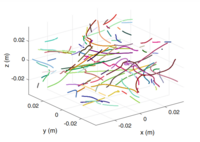
Photo from wikipedia
Flow fields in rotary blood pumps (RBPs) have a significant influence on hemocompatibility. Because flow characteristics vary with flow rate, different operating conditions play a role. Furthermore, turbulence is crucial… Click to show full abstract
Flow fields in rotary blood pumps (RBPs) have a significant influence on hemocompatibility. Because flow characteristics vary with flow rate, different operating conditions play a role. Furthermore, turbulence is crucial in the evaluation of blood damage potential, but the level of turbulence in implantable RBPs is still unknown. In this study, we addressed both research aspects and for the first time measured turbulent flow fields in the HeartMate 3 (HM3) at different operating flows. The averaged, three-dimensional velocity field including fluctuating velocity components in a HM3 with a transparent lower housing was measured using three-dimensional particle tracking velocimetry (3D-PTV). In vitro results were compared with computational fluid dynamic (CFD) simulations for two flow cases, representing the lower and upper physiologic flow range (2.7 and 5.7 L/min), using two different turbulence models that account for fluctuating velocity fields: the k-ω shear stress transport and the Reynolds stress model (RSM). The measurements revealed higher mean and turbulent kinetic energies (TKEs) for the low-flow condition especially within the gap beneath the impeller. Computed mean fields agree well with 3D-PTV for both models, but the RSM predicts the TKE levels better than the k-ω model. Computational fluid dynamic results further show wall shear stresses higher than 150 Pa, a commonly used damage threshold, in the bottom gap for the lower flow condition. In conclusion, the low-flow condition was found to be more prone to blood damage. Furthermore, CFD predictions for turbulence must be carefully experimentally validated.
Journal Title: ASAIO Journal
Year Published: 2019
Link to full text (if available)
Share on Social Media: Sign Up to like & get
recommendations!